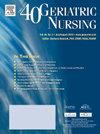Effects of physical exercise on physical and mental health in older adults with gait disorders: A systematic review
IF 2.5
3区 医学
Q3 GERIATRICS & GERONTOLOGY
引用次数: 0
Abstract
The benefits of physical exercise are well-known, but there is limited research on its effects on the physical and mental health of elderly individuals with gait disorders. This review aims to evaluate the impact of physical exercise on these outcomes. A literature search was conducted, retrieving studies published from inception to November 2024 in databases such as PubMed, Scopus, Web of Science, ProQuest, and SPORTDiscus. Fifteen randomized controlled trials (RCTs) were included in the review. The results indicate that physical exercise improves both physical health (gait, balance, mobility, reduce fall rate) and mental health (Qality of life [QoL] cognitive function, anxiety levels, and Activities-Specific Balance Confidence [ABC]) in older adults with gait disorders. Of the 15 studies, 10 reported positive effects on both physical and mental outcomes, while the remaining five studies showed either no effect or a lack of positive results. The interventions evaluated included Tai Chi (TC), Tango, aerobic training (AT), resistance training (RT), combined training (CT), virtual reality (VR), resistance training plus standard pharmacological treatment (RTG + pharmacological treatment), high-speed treadmill training, brisk walking, and multimodal exercise program (MEP). Notably, there are six items of TC intervention. Most interventions lasted for 12 weeks with sessions conducted twice a week, each lasting between 30 and 60 minutes. Additionally, limited studies (one per indicator) assessed strength, functional gait assessment (FGA), and center of pressure (COP), indicating a need for more research in these areas. This review concludes that physical exercise is effective in improving physical and mental health outcomes in older adults with gait disorders, with TC emerging as the most commonly used and beneficial intervention.
体育锻炼对老年步态障碍患者身心健康的影响:一项系统综述
体育锻炼的好处是众所周知的,但对其对有步态障碍的老年人身心健康的影响的研究有限。本综述旨在评估体育锻炼对这些结果的影响。进行文献检索,检索PubMed、Scopus、Web of Science、ProQuest和SPORTDiscus等数据库中从成立到2024年11月发表的研究。本综述纳入了15项随机对照试验(RCTs)。结果表明,体育锻炼可以改善老年人步态障碍患者的身体健康(步态、平衡、活动能力、减少跌倒率)和心理健康(生活质量、认知功能、焦虑水平和活动特异性平衡信心)。在这15项研究中,有10项报告了对身体和精神结果的积极影响,而其余5项研究要么没有影响,要么缺乏积极的结果。评估的干预措施包括太极拳(TC)、探戈、有氧训练(AT)、阻力训练(RT)、联合训练(CT)、虚拟现实(VR)、阻力训练加标准药物治疗(RTG +药物治疗)、高速跑步机训练、快走和多模式运动计划(MEP)。值得注意的是,有六个项目的TC干预。大多数干预持续12周,每周进行两次,每次持续30到60分钟。此外,有限的研究(每个指标一个)评估了力量,功能步态评估(FGA)和压力中心(COP),表明需要在这些领域进行更多的研究。本综述得出结论,体育锻炼对改善老年人步态障碍的身心健康结果有效,TC成为最常用和最有益的干预措施。
本文章由计算机程序翻译,如有差异,请以英文原文为准。
求助全文
约1分钟内获得全文
求助全文
来源期刊

Geriatric Nursing
医学-护理
CiteScore
3.80
自引率
7.40%
发文量
257
审稿时长
>12 weeks
期刊介绍:
Geriatric Nursing is a comprehensive source for clinical information and management advice relating to the care of older adults. The journal''s peer-reviewed articles report the latest developments in the management of acute and chronic disorders and provide practical advice on care of older adults across the long term continuum. Geriatric Nursing addresses current issues related to drugs, advance directives, staff development and management, legal issues, client and caregiver education, infection control, and other topics. The journal is written specifically for nurses and nurse practitioners who work with older adults in any care setting.
 求助内容:
求助内容: 应助结果提醒方式:
应助结果提醒方式:


